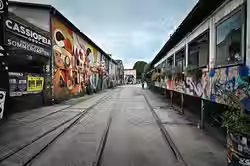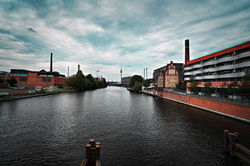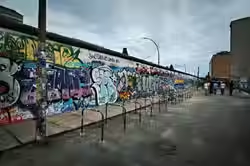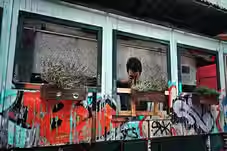
Berlin: A City of Endless Surprises
From Socialist Grandeur to Street Markets and Murals
Berlin is a city of layers — and nowhere is that more evident than in Friedrichshain. On my first day here, I walked through decades of transformation: from the monumental visions of East Germany to vibrant cafés and creative street art. Every turn held a surprise, every wall had a story. This is a photo walk through a neighborhood that balances the weight of history with the pulse of the present.
Grand Beginnings on Karl-Marx-Allee
My day began on Karl-Marx-Allee, Berlin’s grand socialist boulevard. The buildings here don’t whisper; they declare — built to impress, to inspire, and to represent power. The wide street, once known as Stalinallee, is flanked by towering blocks in Zuckerbäckerstil, or "wedding cake style" — ornate, massive, proud.
 |
|---|
 |
 |
 |
📸 Photo tip: Use a wide-angle lens to exaggerate symmetry. Early light or long shadows make these façades even more dramatic.
💡 Did you know? This street was used for military parades during the GDR era. It was meant to be a socialist answer to Paris’s Champs-Élysées.
Walking its length, I could almost hear the distant echoes of marching boots, layered now with café chatter and bicycle bells.


Frankfurter Tor – Between Power and Pause
At the end of Karl-Marx-Allee, I reached Frankfurter Tor, where twin towers stand like sentinels. Built in the 1950s, they marked the gateway to East Berlin’s showcase projects.
📸 Photo tip: Stand in the middle of the crossing for a vanishing point shot — towers rising, traffic flowing, history in motion.
💡 Did you know? The towers were modeled after Russian neoclassicism, intended to show the cultural strength of the socialist regime.
The square feels frozen in time, yet life pulses all around: street vendors, flower kiosks, and trams weaving past layers of the past.

Coffee and Community at Neumanns From the monumentality of the DDR, I wandered into a softer side of Friedrichshain. Tucked into the neighborhood’s quieter streets, I found Neumanns Café — a cozy refuge with warm lighting and the smell of fresh sourdough. 📸 Photo tip: Food photography shines here — top-down shots of the goat cheese toast or shallow depth on the latte art. 💡 Did you know? Friedrichshain’s café culture is thriving, often mixing minimalist design with historical charm. The bread was hearty, the coffee strong, and the people watching — perfect.
 |
|---|
 |
 |
 |
 |
 |
 |
 |
 |
 |
 |
 |
 |
 |  |
|---|---|
 |  |
 |  |
 |  |
 |  |
 |  |
 |  |
 |
Crossing History at the Oberbaumbrücke As the day brightened, I headed south toward the Oberbaumbrücke, one of Berlin’s most iconic bridges. With its red-brick towers and Gothic arches, it looks like it belongs in a fairytale — but its past is very real. Once a crossing point between East and West, it now connects neighborhoods rather than divides them. 📸 Photo tip: Shoot from the riverbank for a silhouette. Try a frame within a frame using the bridge’s arches. 💡 Did you know? During the Cold War, the bridge was closed to traffic. Today it hosts a lively cultural exchange.
Boxhagener Platz – A Quiet Moment Between Markets
Next, I made my way to Boxhagener Platz, a leafy square surrounded by classic Altbau buildings. On weekends, it comes alive with flea markets and food stalls. But today, it was quiet: children playing, locals lounging on benches, and a dog walker nodding hello.
📸 Photo tip: Use the trees as framing elements. Capture textures — cobblestones, benches, aged stone.
💡 Did you know? The square has seen everything from political rallies to punk concerts. It reflects Friedrichshain’s many moods.

 |  |  |
|---|---|---|
 |  |  |
 |  |  |
 |  |  |
 |  |  |
Murals and Memory at the East Side Gallery
Just steps from the bridge lies the East Side Gallery, a 1.3-kilometer stretch of the Berlin Wall turned art canvas. Its murals are political, poetic, and deeply personal — painted just after the Wall fell in 1989.
📸 Photo tip: Focus on individual murals or zoom out to show viewers walking past — interaction makes the story.
💡 Did you know? This is the longest open-air gallery in the world, with over 100 paintings by artists from more than 20 countries.Some works are faded, others refreshed — but all of them speak of freedom, resistance, and remembrance.
A Taste of Time at Markthalle Neun
Crossing the Spree, I reached Markthalle Neun in Kreuzberg, a 19th-century market hall reborn as a food haven. The smell of bread, the hum of conversation, and the rows of stalls created a sensory feast.
📸 Photo tip: Use natural light from the ceiling windows. Close-ups of ingredients or wide shots of the market buzz both work beautifully.
💡 Did you know? The hall was nearly demolished in the 2000s but saved by locals. It now hosts street food Thursdays and artisan festivals.
I ended my day here, sampling cheeses, watching people gather, and soaking up the warm clash of old iron beams and modern appetites.
Final Frame
Friedrichshain taught me that Berlin doesn’t erase its past — it adapts it. From GDR monuments to cafés filled with light and laughter, this walk showed me a city always in transition, but never forgetting where it came from.
👉 Scroll down to view my Friedrichshain photo gallery
📬 Have a favorite Berlin corner? Share your story below.
#BerlinStreetScenes #FriedrichshainWalk #HistoryAndNow #BerlinPhotography #UrbanLayers




 |  |  |
|---|---|---|
 |  |  |
 |  |  |
 |  |  |

Be the first to know
Subscribe to our newsletter to receive news and updates.























